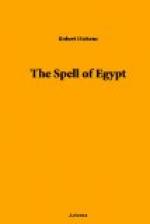What a pastoral it is, this plain of Thebes, in the dawn of day! Think of the reed flute, I have said, not because you will hear it, as you ride toward the mountains, but because its voice would be utterly in place here, in this arcady of Egypt, playing no tarantella, but one of those songs, half bird-like, and half sadly, mysteriously human, which come from the soul of the East. Instead of it, you may catch distant cries from the bank of the river, where the shadoof-man toils, lifting ever the water and his voice, the one to earth, the other, it seems, to sky; and the creaking lay of the water-wheel, which pervades Upper Egypt like an atmosphere, and which, though perhaps at first it irritates, at last seems to you the sound of the soul of the river, of the sunshine, and the soil.
Much of the land looks painted. So flat is it, so young are the growing crops, that they are like a coating of green paint spread over a mighty canvas. But the doura rises higher than the heads of the naked children who stand among it to watch you canter past. And in the far distance you see dim groups of trees—sycamores and acacias, tamarisks and palms. Beyond them is the very heart of this “land of sand and ruins and gold”; Medinet-Abu, the Ramesseum, Deir-el Medinet, Kurna, Deir-el-Bahari, the tombs of the kings, the tombs of the queens and of the princes. In the strip of bare land at the foot of those hard, and yet poetic mountains, have been dug up treasures the fame of which has gone to the ends of the world. But this plain, where the fellaheen are stooping to the soil, and the women are carrying the water-jars, and the children are playing in the doura, and the oxen and the camels are working with ploughs that look like relics of far-off days, is the possession of the two great presiding beings whom you see from an enormous distance, the Colossi of Memnon. Amenhotep III. put them where they are. So we are told. But in this early morning it is not possible to think of them as being brought to any place. Seated, the one beside the other, facing the Nile and the home of the rising sun, their immense aspect of patience suggests will, calmly, steadily exercised, suggests choice; that, for some reason, as yet unknown, they chose to come to this plain, that they choose solemnly to remain there, waiting, while the harvests grow and are gathered about their feet, while the Nile rises and subsides, while the years and the generations come, like the harvests, and are stored away in the granaries of the past. Their calm broods over this plain, gives to it a personal atmosphere which sets it quite apart from every other flat space of the world. There is no place that I know on the earth which has the peculiar, bright, ineffable calm of the plain of these Colossi. It takes you into its breast, and you lie there in the growing sunshine almost as if you were a child laid in the lap of one of them. That legend of the singing at dawn of the “vocal Memnon,” how could it have arisen? How could such calmness sing, such patience ever find a voice? Unlike the Sphinx, which becomes ever more impressive as you draw near to it, and is most impressive when you sit almost at its feet, the Colossi lose in personality as you approach them and can see how they have been defaced.




